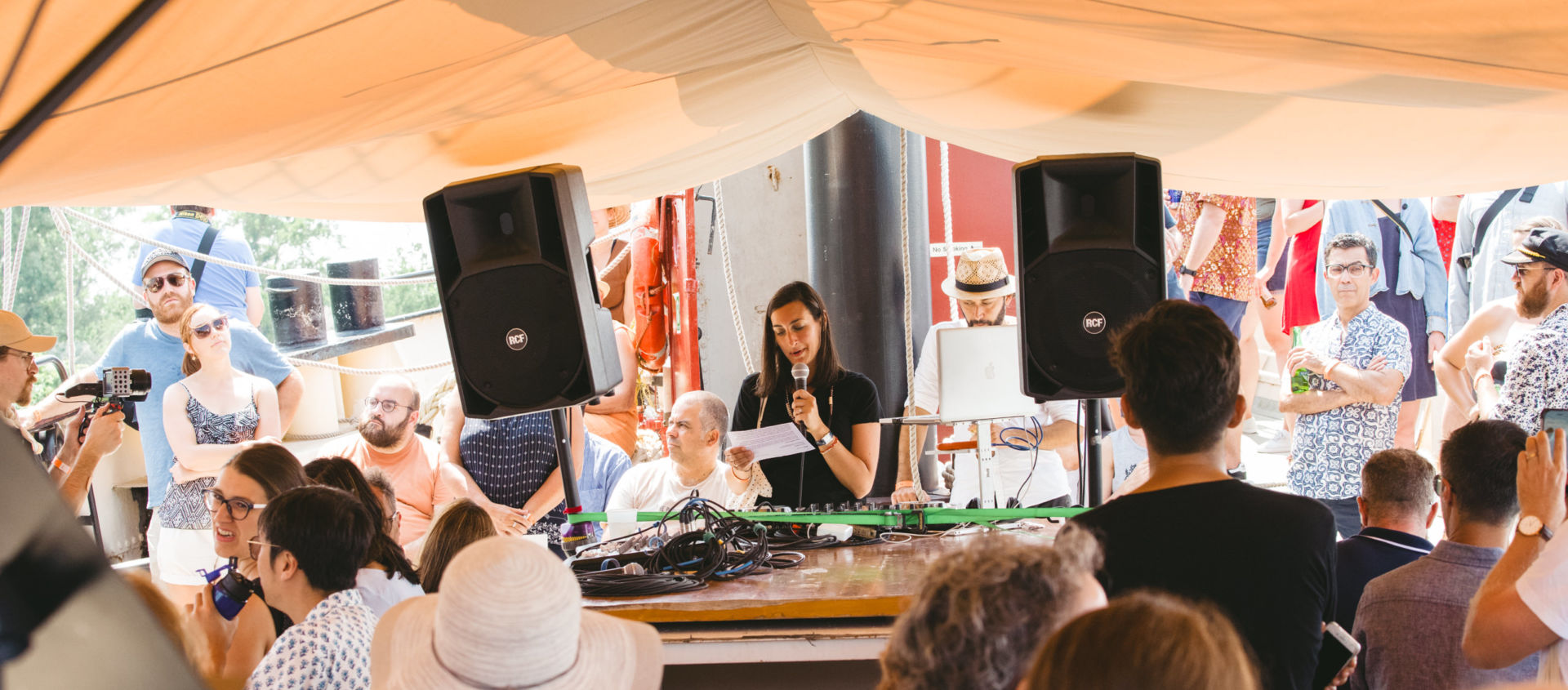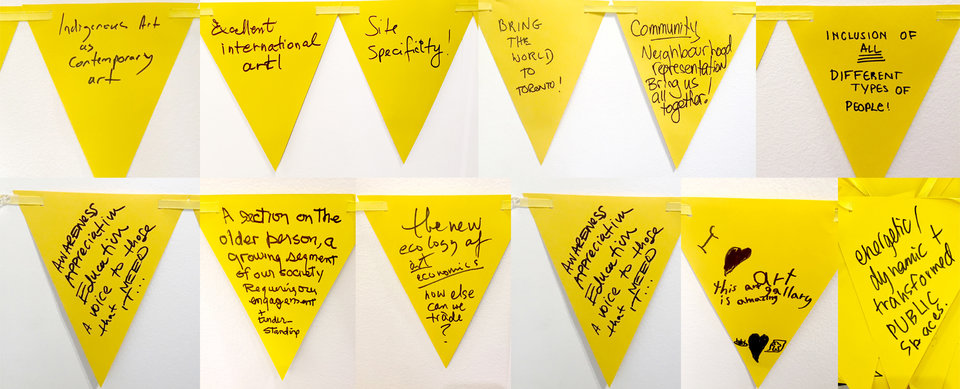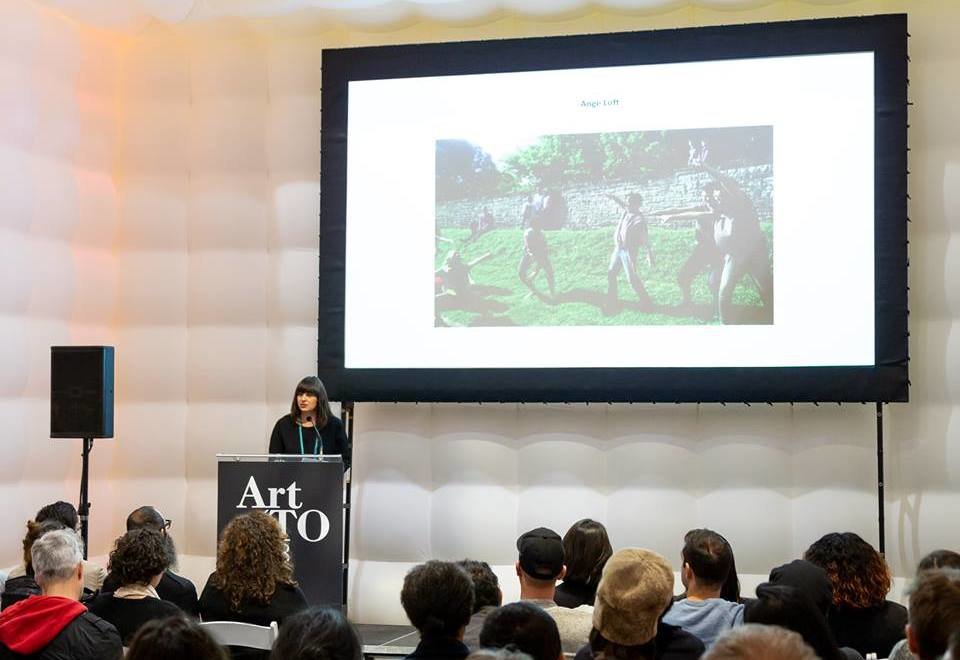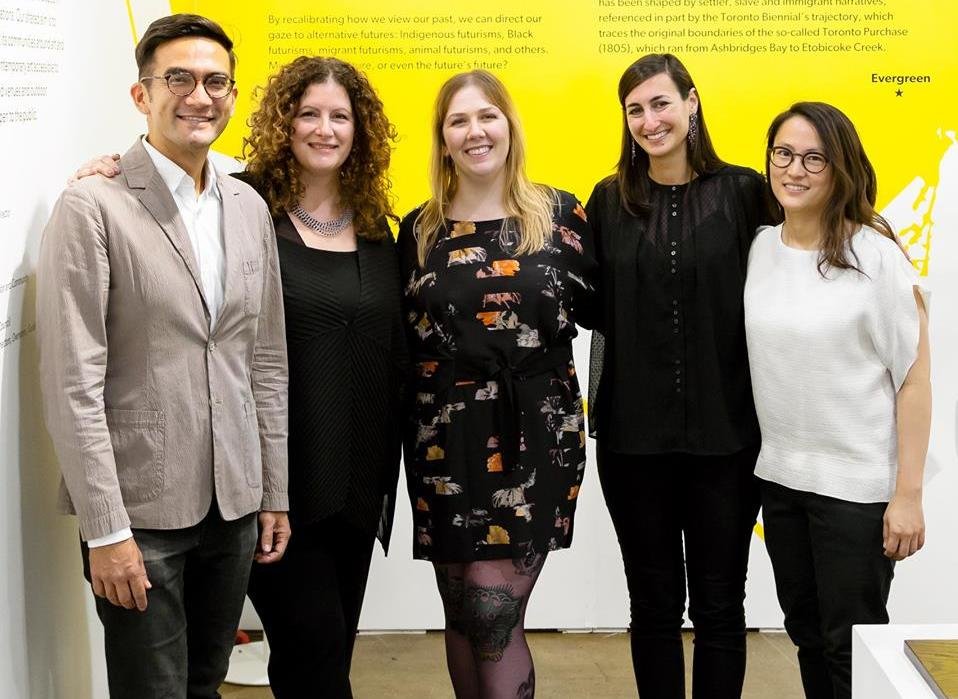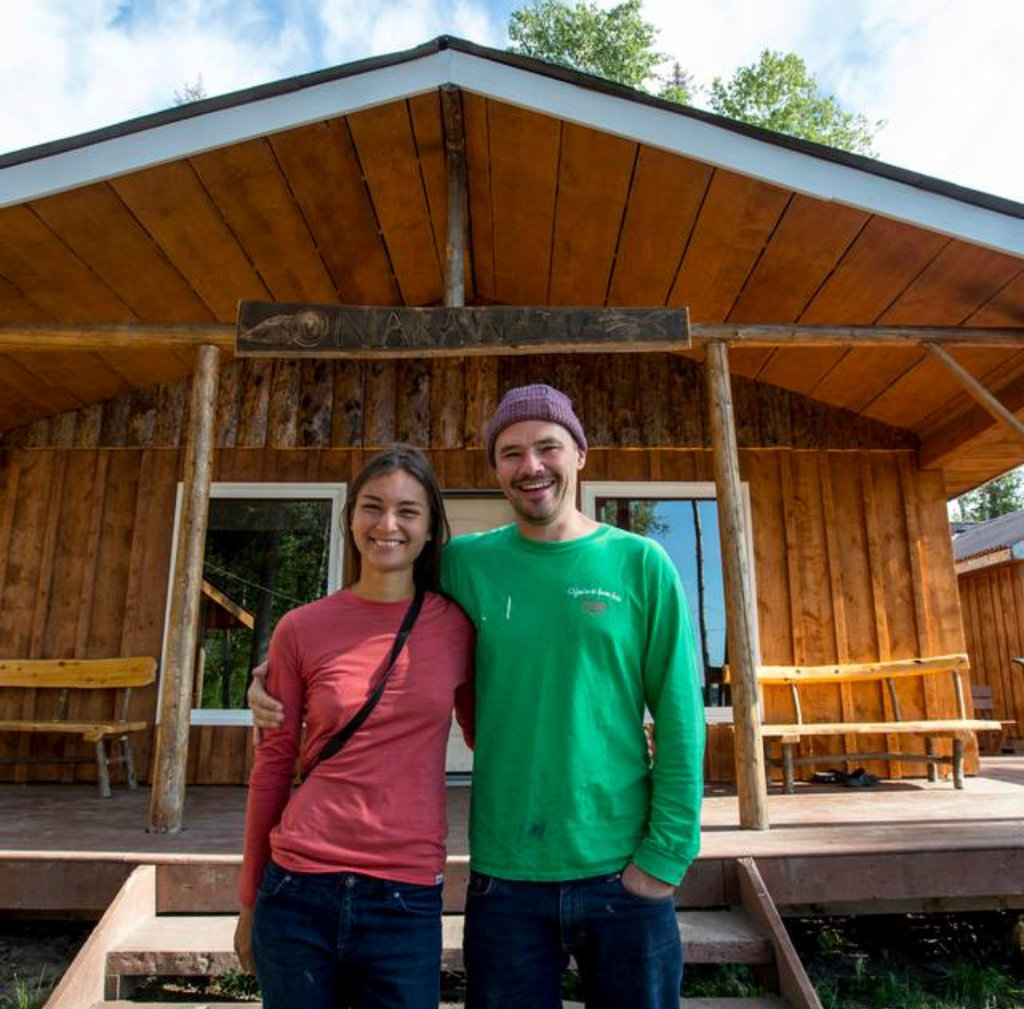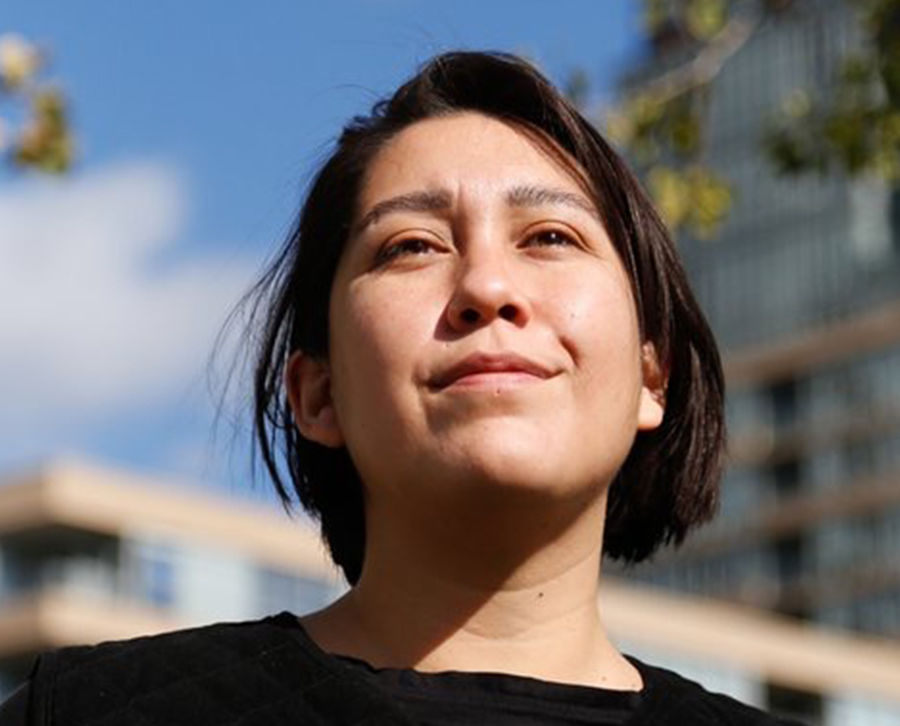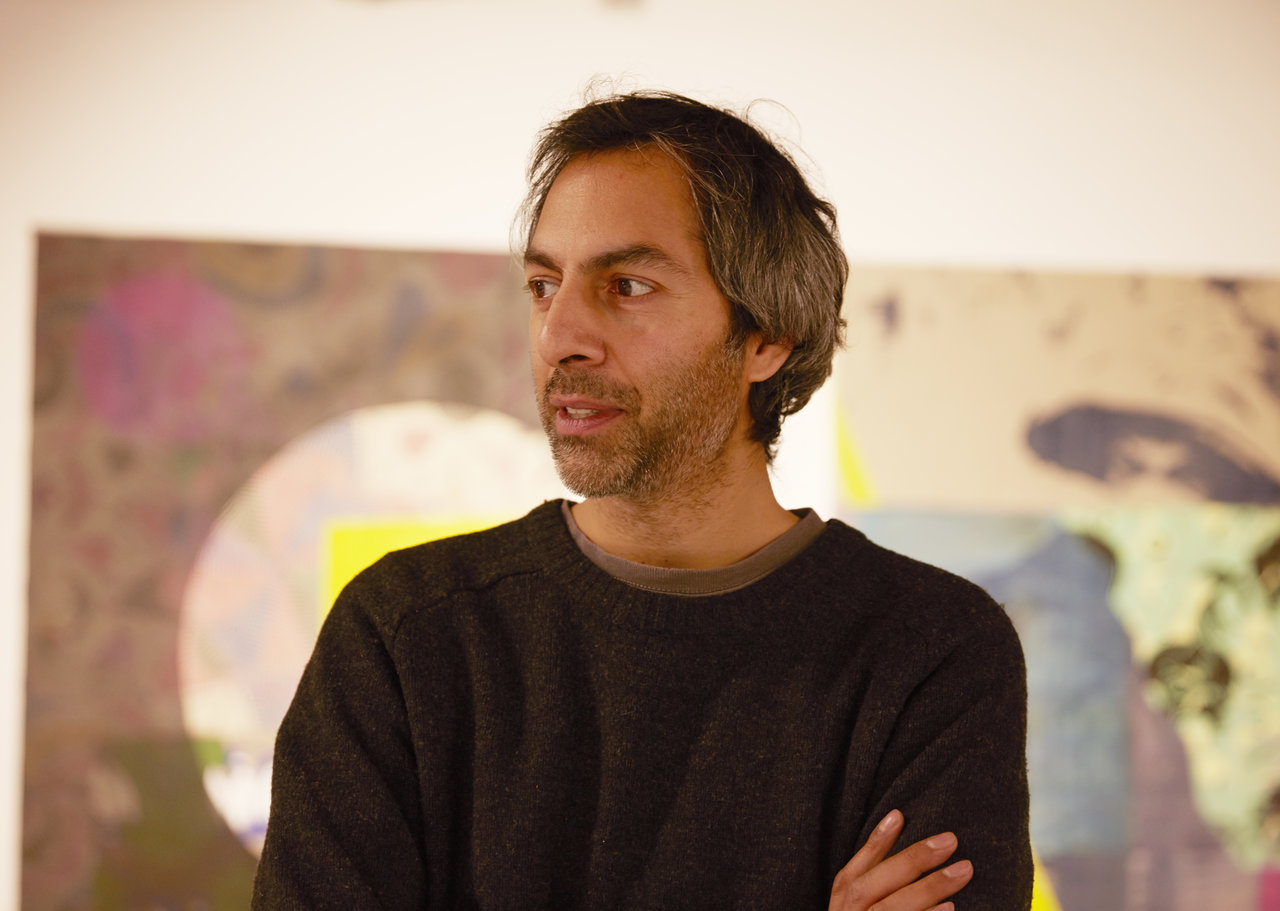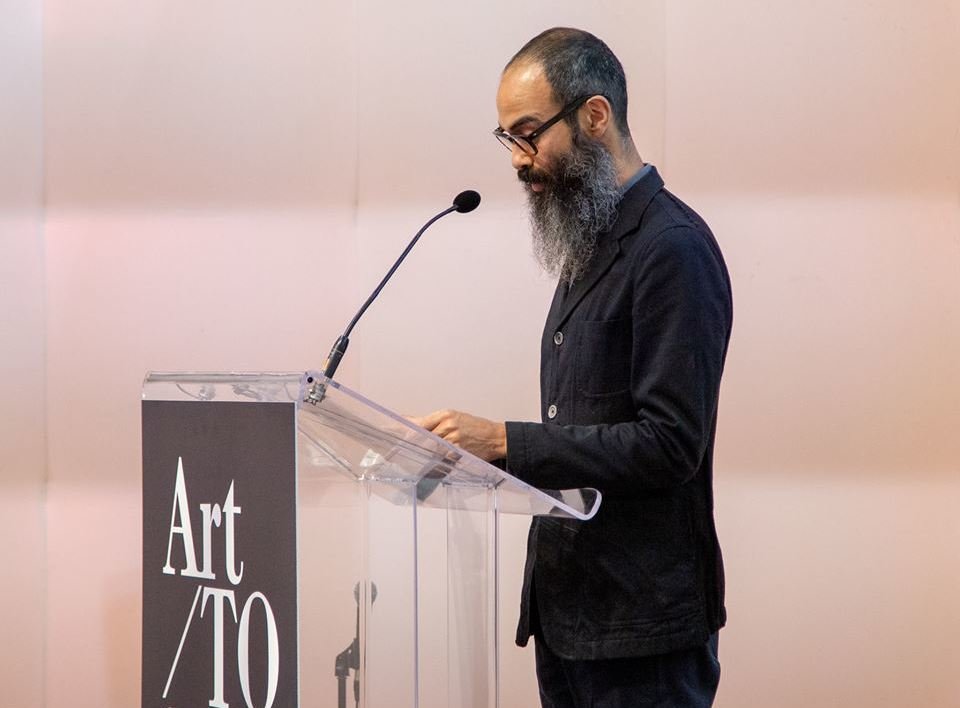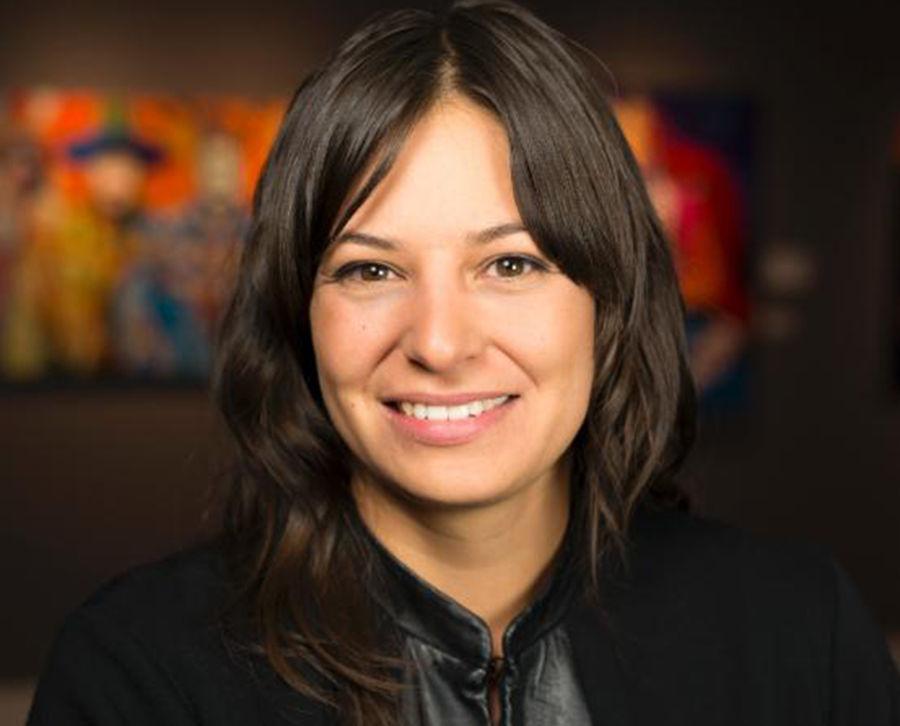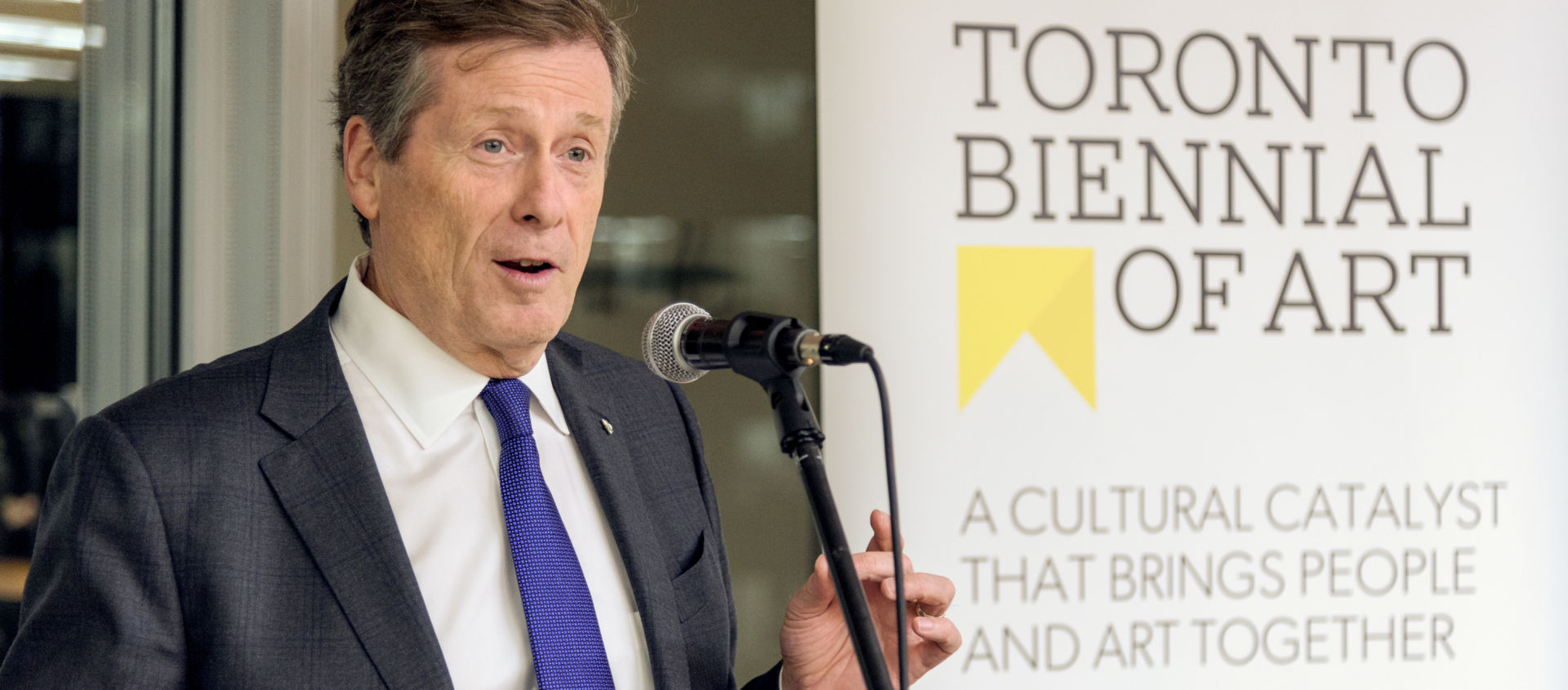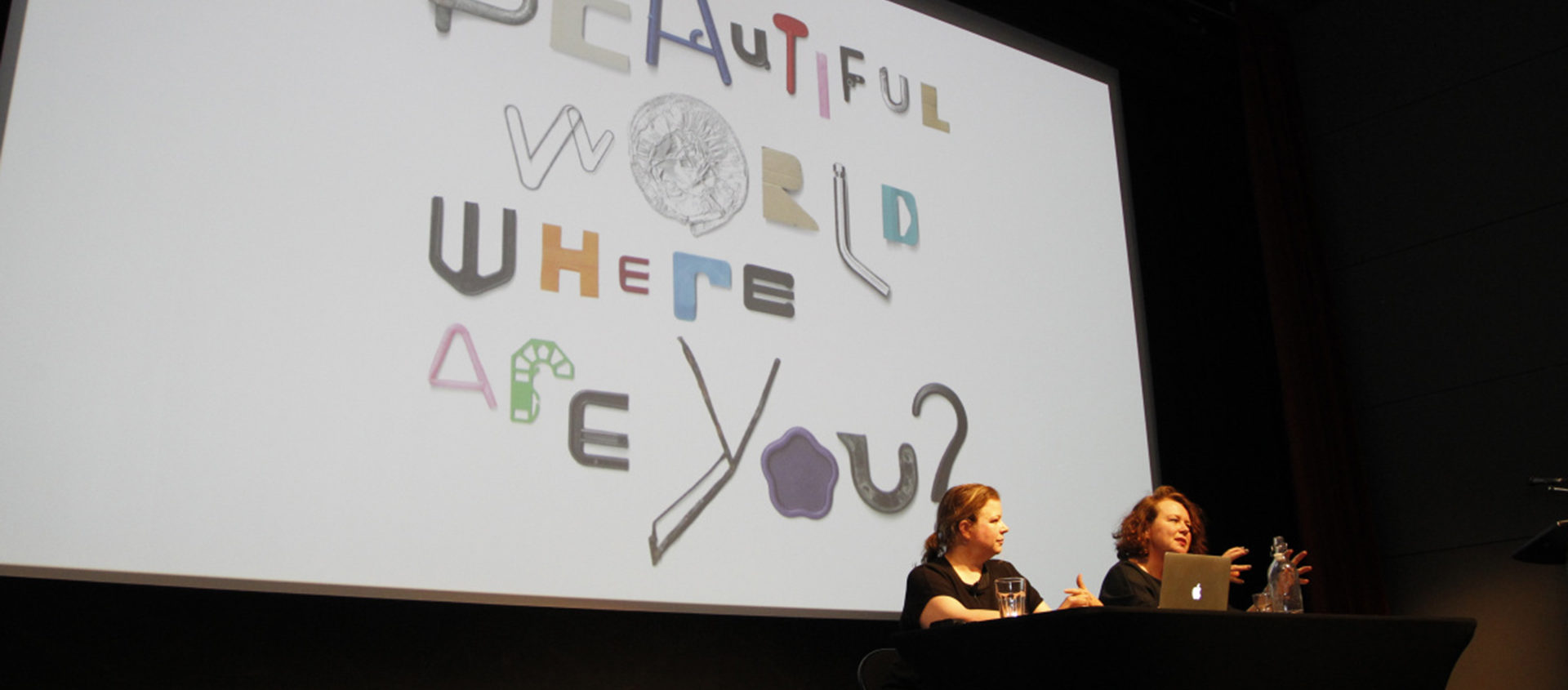A conversation with Executive Director Patrizia Libralato with input from team members Ilana Shamoon and Tairone Bastien by Phil Anderson
(L-R) Curator Tairone Bastien, Executive Director Patrizia Libralato and Director of Programming Ilana Shamoon. Courtesy of TBA
PA: Toronto has for some years entertained the idea of having a Biennial of Contemporary Art (TBA). Why do you think the time is right for the city to have this event?
TBA: There is strong support for starting a biennial in Toronto now for several reasons. Creating a moment with international visibility for the visual arts to shine in the city will: increase visibility for artists, arts professionals, festivals, commercial galleries, collectors and robust collections, as well as cultural institutions, organizations, initiatives and academic programs; help us forge fruitful and lasting creative relationships here and abroad; invite us to lead and participate in global conversations on contemporary art and exhibition making; create a moment of solidarity and unity within the local arts community, where resources are pooled towards collaborative projects.
Toronto Biennial of Art, at the Art Spin Kajama Boat Tour, August 2018, Credit: Priam Thomas from Art Spin, 2018
Beyond local impacts, international cultural leaders and producers are “looking for an excuse” to visit Toronto, as curiosity about our cultural landscape is far-reaching. In frequent conversations with colleagues around the world, we’re being told repeatedly that offering entry points for deeper insights on our city at large, a place with complex histories and innovative cultural initiatives and artistic production, will bring artists, arts professionals, and collectors to Toronto in fall 2019.
PA: What do you see as your vision for this event? What will it look like? I understand much of it will embrace Toronto’s shoreline.
TBA: Our vision for this event is to explore what it means to be “in relation.” The curators are bringing together artists who are reconsidering our relationship with the world, not only with other humans, but also human relationships with animals, the earth, inanimate objects, and even the divine. One could argue that these ideas are a response to increasing nationalism, xenophobia and entrenched borders around the world, not to mention climate change and its terrifying impact. The Biennial will feature artworks that are informed by ancient ideas, alternative histories, sacred belief systems, and ways of knowing. And by tethering ourselves to more interconnected world-views, the Biennial will also point to alternative futures.
Participatory flags at Toronto Biennial of Art booth at Art Toronto, 2017. Courtesy of TBA
The Biennial will consist of site-specific commissions and recent artworks by these artists. These works will be sited in buildings and outdoor spaces along Toronto’s waterfront, focusing on a span of shoreline from Ashbridges Bay to Etobicoke Creek. Although we didn’t set out do this, we realized only after securing sites at either end that we trace the original boundaries of the so-called Toronto Purchase. This is important for us to think about, as one layer of history upon many. We also know that the First Peoples maintained a presence here for over 15,000 years. The waterfront is a site of spiritual healing, trade, treaty, and gathering, but it is also deeply inscribed by settler, slave and immigrant narratives. Unpacking all of these histories means we see this landscape “in relation” and our role in a multitude of ecosystems.
Map of locations for Toronto Art Biennial, Fall 2019. Courtesy of TBA
PA: What do you see as the biggest challenge of putting together such a big event?
TBA: Launching a new event is always challenging. There is a fair amount of groundwork that needs to be laid, education that needs to take place and support that needs to built – political, philanthropic and community. Building a structure from the ground up and getting it funded is so small feat, but we have been working on this project for years and have put in the hard work of commissioning and authoring various plans and frameworks that are integral to the project.
Art Toronto Talk on Toronto Art Biennial, October 2018. Courtesy of TBA
As we build our biennial community, connecting with other events around the world, we are told, however, that this is the case for most new and comparable initiatives! Space in general is a challenge in this city. We are animating the waterfront and looking for unique, mainly non-institutional spaces for our exhibitions, and working towards confirming the most interesting and unexpected sites by the end of this year. What has made this project a success to-date is our overall team. We have some of the city’s greatest cultural leaders and minds supporting us and we have built an amazing core staff team and will continue expanding it in the early new year.
(L-R) Tairone Bastine Curator. Patrizia Libralato Executive Director, Sabrina Maher Development Manager, Ilana Shamoon Director of Programming and Myung-Sun Kim Assistant Curator, Public Programming and Learning. Courtesy of TBA
PA: How has it been received internationally? Will there be a lot of international participation?
TBA: International colleagues are excited by the Biennial for several reasons. First, there seems to be a growing interest in Toronto given its acclaim as the most diverse city in the world. The Biennial will definitely reflect this, featuring artists from diverse backgrounds both living in Canada and internationally.
PA System, Alexa and Patrick. Photo: Tyler Anderson
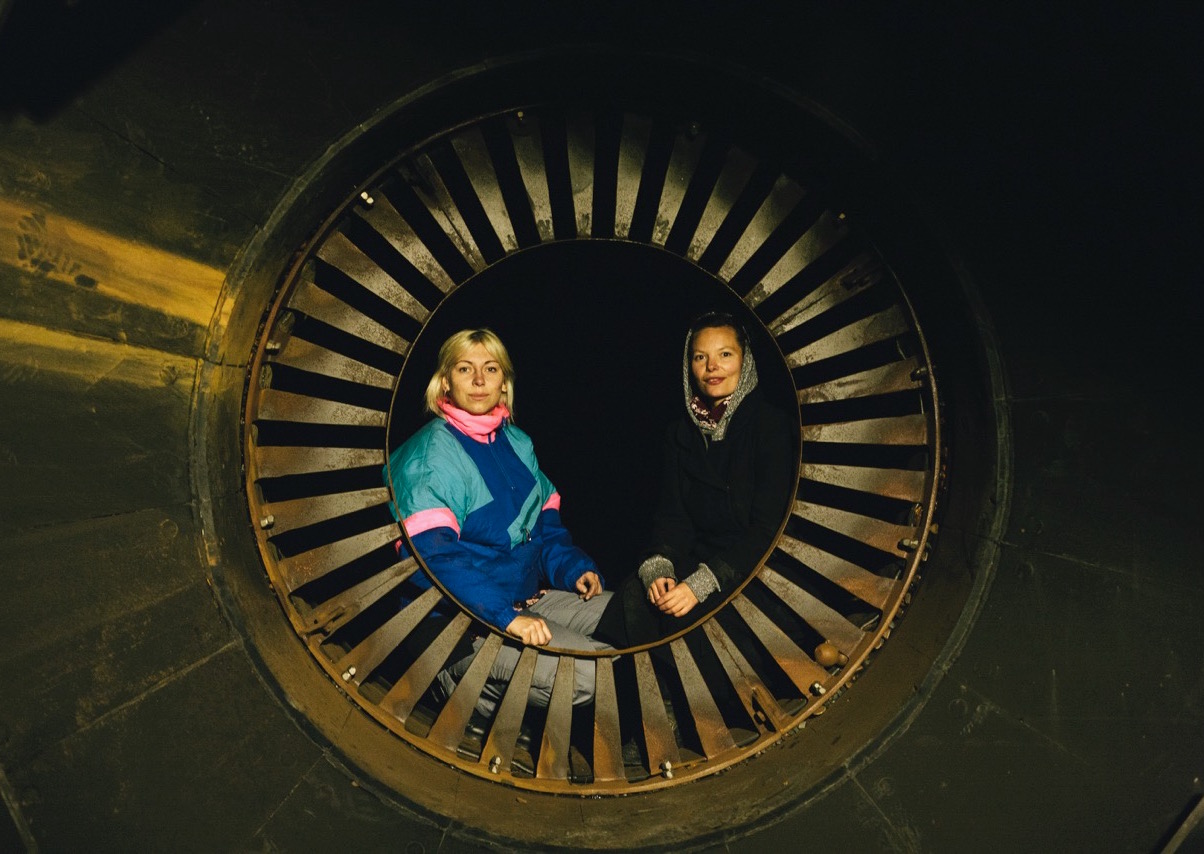
New Mineral Collective, Emilija Skarnulyte and Tanya Busse. Photo: Micheal Miller
Naufus Ramirez-Figueroa, Bananos. Photo: Isaac Martinez
Second, our country is at the forefront of the global conversation on Indigenous rights. The Toronto Biennial is rooted by what we’ve titled the “Indigenous Context Brief” written by Ange Loft, that describes in great detail the complex Indigenous histories and narratives of the waterfront. This was shared with our curators and they’ve passed it on to the artists they’re working with. It has informed their curatorial thesis and will influence the Biennial’s programming. This sets our Biennial apart from other Biennials around the world, and is a strong lure for people interested in seeing work by artists invested in these issues.
Ange Loft, Advisory Council. Photo: Liam Coo
The Biennial will involve a lot of international artists, alongside Canadian artists. We are focused on presenting a biennial that tackles global topics and narratives that stem from and are deeply connected to concerns and issues, on the ground, in Toronto and across Canada.
PA: Are there Indigenous artists participating in the Biennial? Are they included in the programming?
TBA: Yes, there will be a number of Indigenous artists participating, both Indigenous to Canada but also Indigenous folk from other parts of the world. Among the artists we just announced, for instance, are Caroline Monnet, a multidisciplinary artist from Outaouais, Quebec who is of Algonquin and French heritage; Ange Loft, a multi-disciplinary artist and performer from Kahnawake Mohawk Territory; and Embassy of Imagination, a collaborative and socially-engaged project in the high arctic that involves Inuit youth in Kinngait, Cape Dorset, Nunavut.
Embassy of Imagination. Photo: Joseph Pinguartuk and EOI
PA: Are other cultural institutions participating as venues or in programming, i.e. the AGO, MOCA and the Power Plant?
TBA: We are partnering with several institutions, like MOCA, the Power Plant, the Art Museum at the University of Toronto, and the Ryerson Image Centre, to create closely connected programming. These spaces will present exhibitions of work by artists also participating in the Biennial along the waterfront, encouraging visitors to go to these partner spaces to get a fuller picture of a given artist’s work.
(L-R) Power Plant, Harbourfront, Art Museum of University of Toronto and MOCA
For example, MOCA, along with the Biennial, Fogo Island Arts, and A Tale of a Tub (Rotterdam), will be co-commissioning a work by Shezad Dawood that will be shown at both MOCA and a Biennial location as part of two different but related installations, inciting visitors to move from one cultural space to another.
Shezad Dawood. Photo: Sue Parkhill
PA: How might Toronto’s Biennial differ from others? What will make it unique?
TBA: Toronto’s biennial has two important distinctions. First, is the fact that the curators have been invited to curate over the course of two iterations. This allows the curators to think more long-term about projects, and to allow works to develop over time. Some projects will be presented iteratively, with elements exhibited in 2019 and others exhibited in 2021. The model is ideal for artists with research-heavy practices, who take a deep dive into a topic.
Toronto-based artist and curator Luis Jacob has been commissioned to create the first Toronto Biennial Artist Edition, entitled The Riddle. The artist at Art Toronto, 2018
Luis Jacob, The Riddle, 2018, Epoxy resin and marble dust, approximately 24 x 12 x 4 inches.Courtesy of Birch Contemporary, Toronto.
Secondly, the curators are based in the city, rather than flying in temporarily to organize the Biennial. Being based here enables the curators to be more integrated into the Toronto arts scene. It’s enabled things like our partnership with OCADU in which we are integrating the biennial into the curriculum, working with students, alumni and professors. In addition, one of our curators, Candice Hopkins will be teaching a course there in the spring.
Candice Hopkins. Courtesy of TBA
PA: What has been the reaction in terms of support (financial and other wise) for this cultural event?
TBA: We have received considerable support to date, both in terms of financial contributions and other forms of partnership. We previously spoke about our creative partnerships with cultural institutions – and there are many more. We are also connected to OCAD University through a deep partnership that sees OCAD embedding the Biennial into its curriculum cross-departmentally. In terms of venue partners, Harbourfront Centre, Ontario Place, Artscape, the Small Arms Inspection Building (through the generous support of the City of Mississauga), and more have come on board offering space. Financially, banks like TD Bank Group and CIBC have supported us early on and developers like Castlepoint Numa and Menkes Developments are strong supporters. We are also grateful for the funding we’ve received from the City of Toronto and the Government of Ontario that have kept us working towards our launch.
Mayor John Tory at the Toronto Biennial of Art launch event November 2017. Courtesy of TBA
PA: Have you used other Biennial events to try and shape Toronto’s? If so, how?
TBA: Many projects have informed how the Toronto Biennial has taken shape. However, the Liverpool Biennial, through its fierce and generous leader, Sally Tallant, has been the most significant influence. Sally’s voice has been a constant in our research from the outset, and continues today. She has transformed the Liverpool model into one that is deeply connected to her city, with year-round programming – the “perennial biennial,” as she says. Beyond Liverpool, she’s extended her project internationally with co-commissions, co-productions, and staff exchanges. Her commitment to supporting local artists, and sharing information and resources is inspirational and will remain her legacy as she moves on next year to lead the Queens Museum.
Sally Tallant (left) and Kitty Scott (right) Talk co-presented by Toronto Biennial of Art and the Art Gallery of Ontario, May 2018. Courtesy of TBA
PA: Toronto’s Nuit Blanche started out for the first 5 years to be well received by the public but seems to have decreased in popularity. How do you think Toronto’s first Biennial will be received and how might the interest be maintained?
TBA: Nuit Blanche has been an extremely important model for us – without Nuit Blanche, we could not have gained as much traction as we have around the Biennial. It has shown the city how valuable a large scale, free contemporary art event is. It has also trained young curators to work in public space; in fact, both our curators, Candice Hopkins and Tairone Bastien, have curated Toronto Nuit Blanche events in the past. Nuit Blanche has evolved over the years, and its recent presence in Scarborough was very successful. We are partnering with Nuit Blanche in various ways, as our events overlap in terms of timing. Like Nuit Blanche, we are thinking carefully about sustainability and audience engagement. Key to our project is year-round programming and continuity between Biennial events. Each event will build from what has come before it, and will be closely connected to the specific context of the city, encouraging visitors to understand Toronto in new ways, through new lenses. We expect this continued engagement, coupled with excellent curatorial choices and innovative public programming, to maintain interest in our project.
Shalak Attack, Universal Language, 2016, Part of Mirrors of Babel, a mural at Lawrence East Station, Nuit Blanche 2018, form The things they carried, curated by Tirone Bastien. Photo: Clandestinos
PA: Is there any one part of the event or programming that excites you the most?
TBA: There are too many to talk about and not everything has been announced yet! But for now, I can say that I am excited for people to explore the waterfront in a new way, thinking deeply about its history and its future.
*For more information and update please go to https://torontobiennial.org/


